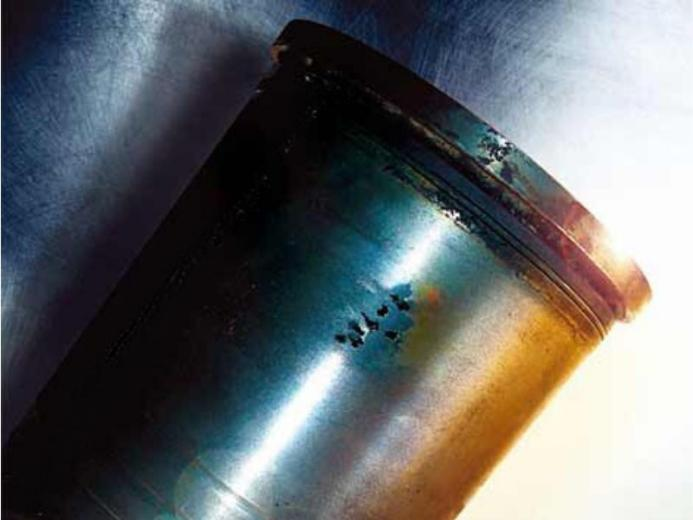Hydraulic cylinders are the heart of a hydraulic system and are the key components responsible for converting hydraulic energy into mechanical force. Cavitation, particularly in the context of hydraulic cylinders, refers to the formation and subsequent collapse of air- or vapor-filled cavities in the hydraulic fluid. This phenomenon can lead to reduced system efficiency and damage to the hydraulic cylinder itself.
Cavitation within hydraulic cylinders is a significant issue where vapor-filled cavities or bubbles form in the hydraulic fluid. This typically occurs when there is a substantial pressure drop below the fluid's vapor pressure, leading to localized boiling. Such scenarios are commonly triggered by abrupt pressure fluctuations, which are not unusual during the normal operation of hydraulic systems.
At the core of cavitation is the concept of fluid pressure dynamics. When there is a rapid decrease in pressure, the hydraulic fluid transitions into a vapor state, forming bubbles. These bubbles are inherently unstable and prone to collapsing once the pressure stabilizes. The collapse of these bubbles is a high-energy event that can cause significant damage, such as pitting or erosion, to the internal surfaces of the hydraulic cylinder.
Cavitation in hydraulic cylinders, although similar to the phenomenon in pumps and turbines, has distinct characteristics. The specific conditions under which cavitation occurs in hydraulic cylinders, and the resulting impacts, necessitate tailored approaches for diagnosis, prevention, and management. This understanding is crucial for maintaining the efficiency and longevity of hydraulic systems, as the mechanisms and outcomes of cavitation can differ significantly from those in other types of hydraulic equipment.
Cavitation in hydraulic cylinders can arise from several interrelated factors that impact the system's performance.
A hydraulic system that is not optimally designed can create conditions favorable to cavitation. For example, incorrect component sizing or inadequate pressure settings can lead to sharp pressure drops, causing the formation of vapor bubbles in the fluid.
The implosions of these cavitation bubbles are not only mechanically damaging but also generate significant heat. These implosions can momentarily raise temperatures to extreme levels, sometimes as high as 5,000°F. Additionally, the surface damage caused by cavitation increases friction when the fluid moves across these eroded surfaces. This increased friction leads to efficiency losses in the system and contributes to further heat generation. As a result, the presence of excessive heat in a hydraulic system can be a strong indicator of ongoing cavitation issues.
The viscosity of the hydraulic fluid is critical in the occurrence of cavitation. Fluid that is either too thick or too thin for the system's operating conditions can contribute to cavitation. Similarly, significant temperature fluctuations can change the fluid’s viscosity, making it more prone to vaporization under pressure changes.
Regular maintenance is essential for the health of hydraulic systems. Neglecting maintenance can result in the wear and tear of components such as seals and valves, leading to uneven pressure distribution and the subsequent formation of cavities. Additionally, the presence of contaminants in the fluid, due to inadequate maintenance, can worsen the cavitation process.
A comprehensive understanding of these factors is crucial for the proactive management of hydraulic systems, helping to prevent cavitation and ensure their efficient operation.
In hydraulic systems, the early detection of cavitation is key to preventing major damage. Understanding and recognizing the symptoms of cavitation can make routine maintenance easier and significantly reduce the need for major system repairs.

One of the primary indicators of cavitation in hydraulic cylinders is unusual sounds emanating from the system. These are not the typical operating noises but rather a rattling or knocking sound, which indicates the implosion of air bubbles. This audible signal is often the first warning sign that a technician will notice, signaling the need for a closer inspection.
Upon physical inspection, cavitation leaves unmistakable signs of its presence. Pitting and erosion on the surfaces of cylinders, especially on the inner walls or the piston, are characteristic indicators. These marks are not just superficial scratches; they are deep, irregular indentations caused by the forceful collapse of vapor bubbles within the fluid. Early recognition of these signs can prevent the damage from worsening over time.
Operational performance also provides key insights into cavitation. A reduction in system efficiency, unpredictable movements, or unexplained variations in force can all signal underlying issues. Cavitation disrupts the smooth flow and pressure of hydraulic fluid, leading to these inconsistencies. Closely monitoring performance metrics can help detect cavitation at an early stage.
The timely identification of these symptoms is crucial. Promptly recognizing and addressing them can significantly reduce the time and resources required for the maintenance and repair of hydraulic systems.